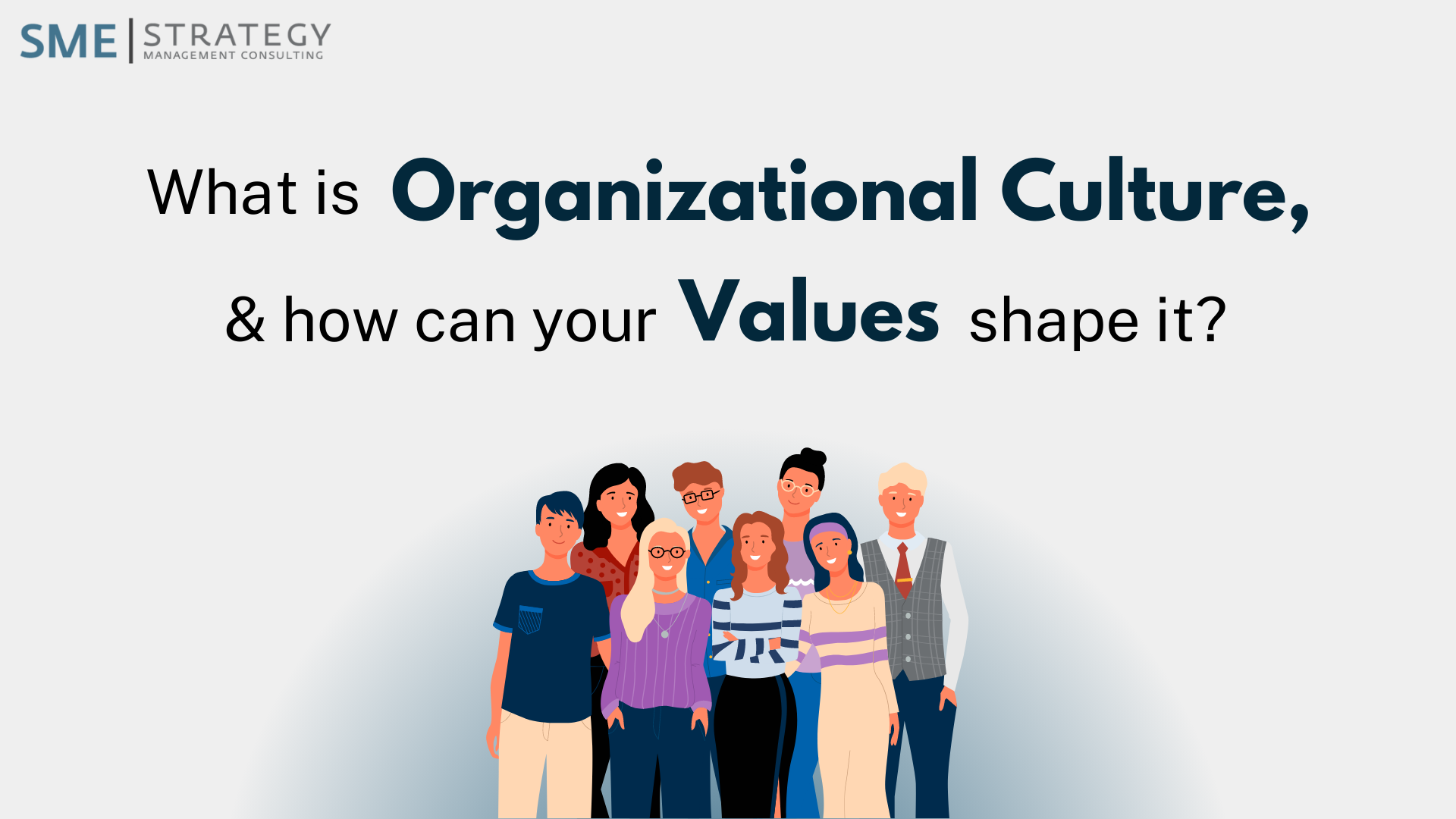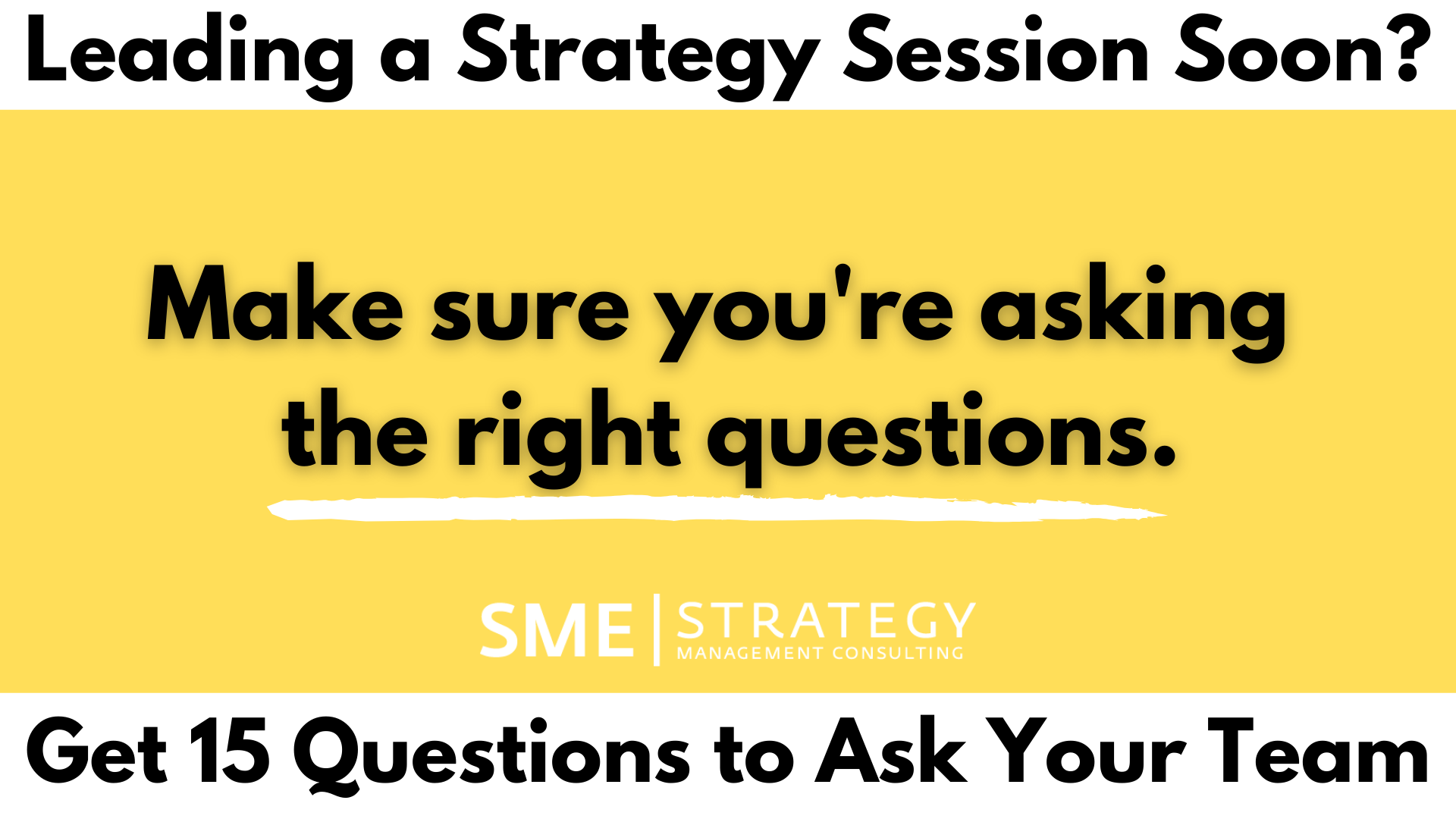What is Organizational Culture? And How Can Your Values Shape it?

SME Strategy is a strategy consulting company that specializes in aligning teams around their vision, mission, values, goals and action plans. Learn more about how we can help align your team with our strategic planning and implementation services.
What is organizational culture?
Organizational culture or company culture is an outcome that arises organically as it is shaped by elements such as shared experiences, beliefs, knowledge, language, rituals, and common values. Just as culture emerges within societies, culture emerges within organizations - with or without input from leaders.
While your organizational culture cannot be forced or created, it can be intentionally shaped and fostered by leaders. Values and behaviours are one of the core components of culture that your organizational leaders can focus on to help shape a desired culture that can drive performance and propel the organization towards its vision and mission.
>> Watch: Organizational Culture: Best Practices & Examples
Why should leaders care about fostering organizational culture?
Because culture is a result of an organic process, it is often a qualitative lagging indicator of how your organization is doing. This means that if your leaders do nothing to foster your culture, a culture will still emerge, and it may or may not be aligned with the organization’s vision and mission.
Sometimes organizations have ambiguous values without clear behavioural expectations for their people to follow. It is critical that your leaders explain the desired values and their associated behaviours in a clear and unambiguous way so that everyone knows what is expected of them. Additionally, it is important that your leaders do not demonstrate or reward undesirable behaviours, or behaviours that counter the stated values. Otherwise, undesirable behaviours will continually emerge throughout the organization rather than the desired behaviours.
If undesired behaviours begin to emerge, a counter culture may surface, with several people demonstrating a different set of values that may not align with the organizational values and overall vision and mission. This counter culture is similar to having a bowl of apples on your counter where some apples have gone bad or moldy. When picking through these apples, you’ll find rot and mold has often spread to nearby apples. While apples on the periphery likely remain healthy, the longer they remain in the bowl with the rotten or moldy fruit, the more likely they too will become impacted.
We can help you align your team around a clear vision, mission, values, goals and action plans,
so you can lead your organization more effectively and get better results.
Communicating, demonstrating, & reinforcing desired values & behaviours
Instead of leaving your organizational culture to chance, your leaders can place a strong focus on clearly communicating, demonstrating, and rewarding desired values and behaviours.
This way, you can foster a higher likelihood that these will cascade throughout the organization and become embedded in the fabric of the organizational culture.
To do this, leaders must first discuss and align around the values they would like to emulate throughout the organization in order to help reach its vision and mission. Values can be subjective, however it’s important that specific behaviours and actions are identified that align with or contradict each value.
For example, the word ‘respect’ might carry a different meaning to different individuals. By connecting specific behaviours to each value, this helps to ensure that everyone can have a common understanding of what it means to live this value. Is respect showing up to meetings on time? Is it taking time to connect with individuals outside of one’s department? This will depend on your organization, and it’s important to make sure that these are explicit rather than implicit so people know what types of behaviours are expected of them.
Your leaders will need to communicate and share these values with everyone throughout your organization. This can be done in a one-to-many or one-on-one setting, depending on the size and needs of your organization. While one-way communication may be sufficient, two-way communication is encouraged. This will give your people a chance to ask questions and to share their perspectives on how they can demonstrate these values within their department or role.
Repetition is also helpful when discussing values and behaviours. Consider posting these physically or digitally in a place they can be easily viewed, accessed and discussed on a regular basis.
Then, your leaders must be prepared to consistently demonstrate these desired behaviours so that others will follow their example. If leaders act counter to the values they request and expect of their people, the desired values and behaviours (and ultimately your organizational culture) will not emerge.
They must also be prepared to reinforce these behaviours. This means recognizing and rewarding those who demonstrate desired behaviours and having discussions or taking disciplinary action with those who do not. Additionally, carefully checking for values alignment can be a great way to hire and onboard the right people for your organization.
A common mistake for your leaders to watch out for is rewarding behaviours that contradict your values. For example, if your organization claims it values collaboration and teamwork, but consistently promotes those who demonstrate individualistic or selfish behaviours, a culture of collaboration and teamwork will not emerge. People will think and act for themselves if there is a benefit to behaving this way.
Shifting an existing organizational culture
As stated earlier, your organizational culture or company culture emerges as an organic process and cannot be forced or created. This means that if your leaders want to foster a cultural transformation, they will need to engage their people and achieve buy-in for this change. Before discussing desired values and behaviours, your leaders will need to identify and discuss current undesired behaviours that exist within the organization, and communicate why they are not effective and will no longer be accepted.
Spoiler alert:
For those who may be Ted Lasso fans, consider Jamie Tartt’s behaviour early on in the series. He is constantly praised for being a star player, despite being disengaged and disrespecting his team members. It’s not until he leaves the team and tries to return that there are consequences for the way he behaves. Both his coach and teammates explain they will no longer accept selfish behaviour and share the behaviours that are expected of him to return. He is only rewarded and trusted when he behaves in a way that promotes the team’s collective success. This shift, facilitated by coach Ted Lasso, resulted in a stronger team culture, ultimately helping them move closer to their shared vision.
Unlike on TV, this change initiative will likely take 18-months to 2-years. If leaders talk the talk, walk the walk, and reinforce behaviours alongside following change management best practices, it is likely that the desired organizational culture will emerge.
Need help with your strategic planning process? A facilitator can help:
Why does organizational culture matter?
Beyond developing a workplace where your employees are motivated, productive and want to come to work, fostering an intentional organizational culture will help your organization implement your strategic plans and move towards your desired future.
Your organization can have a brilliant strategic plan, but without a culture that aligns with the vision and mission, strategy implementation may become stagnant or fail. Peter Drucker famously said, “Culture eats strategy for breakfast”. Your strategy will only go as far as your people will take it. By ensuring that your organizational leaders communicate, demonstrate and reinforce values with the intention of crafting a culture that will align with its vision and mission, your organization will be more likely to successfully implement your plan. Strategy and culture are explicitly linked.




